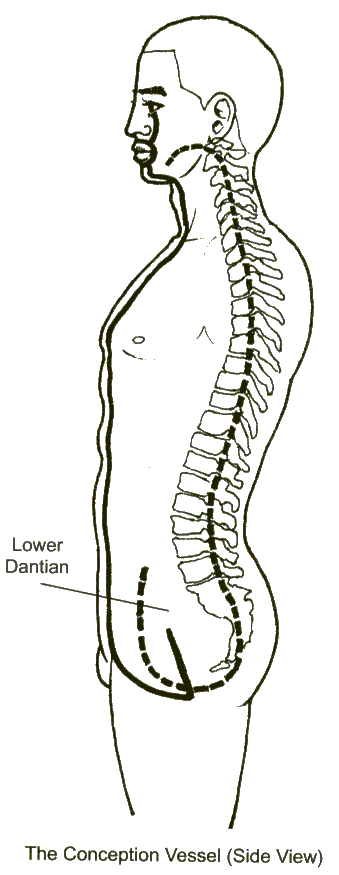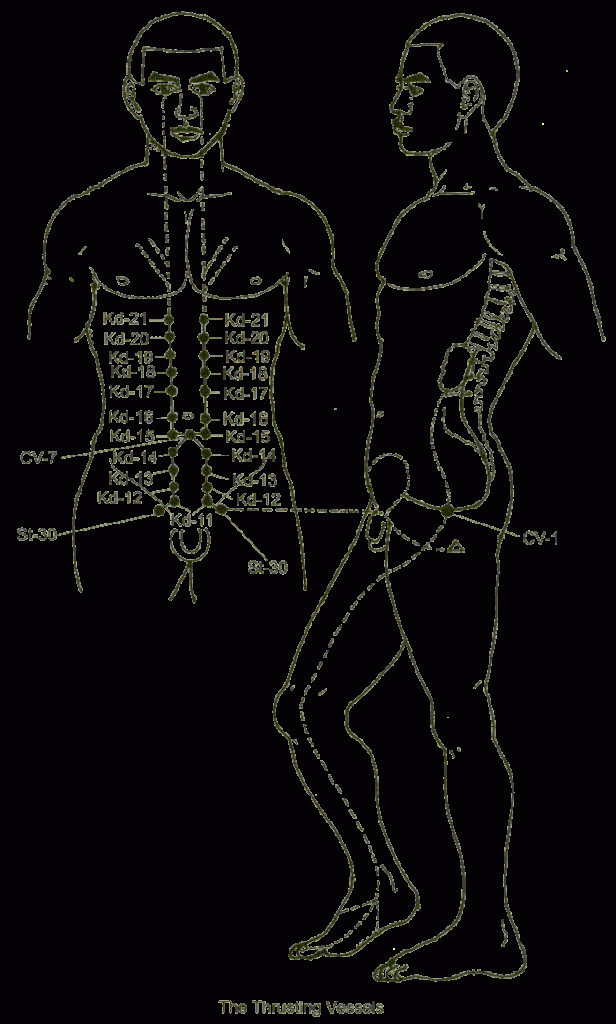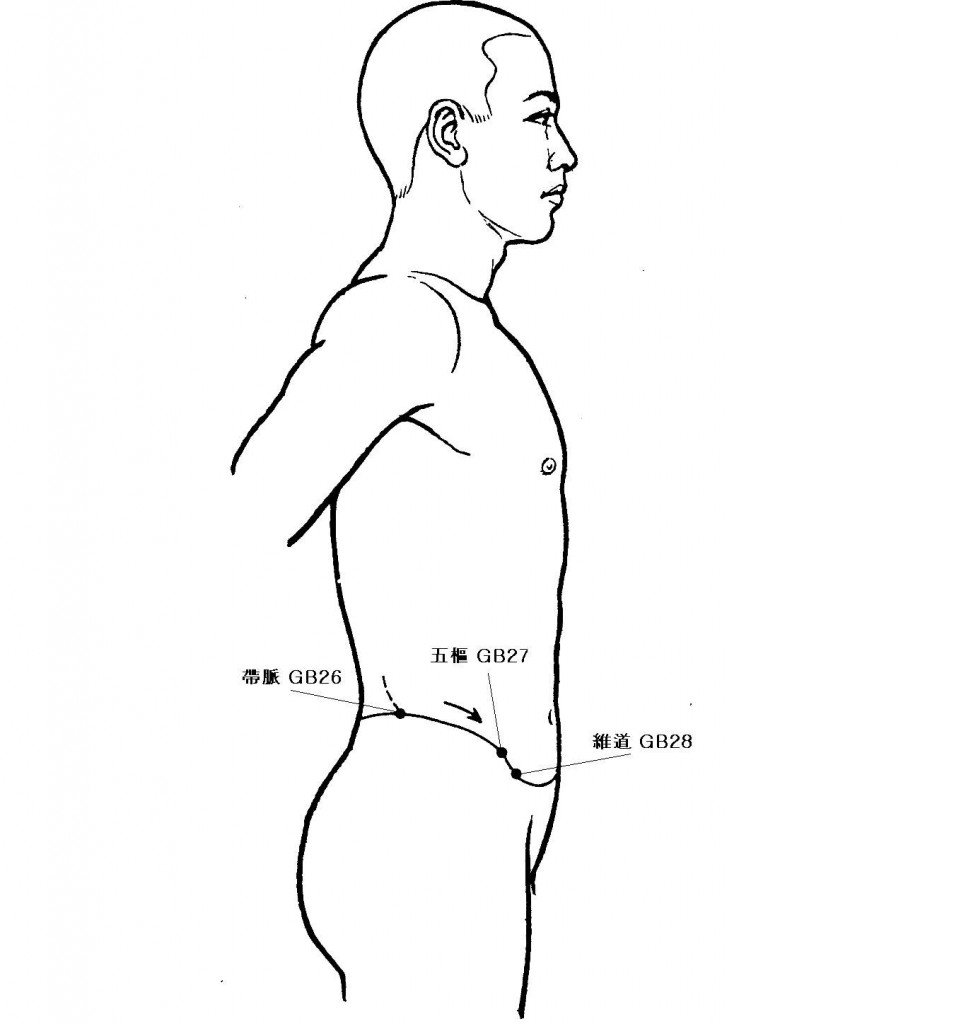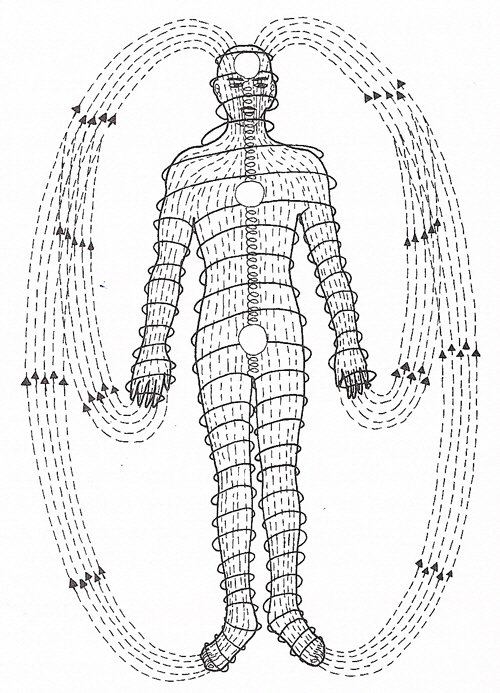[Scientific Qi Exploration 气的科学探讨]
The Extraordinary Meridians or Vessels (Part 2)
Marty Eisen Ph.D.
(Continue from previous poster, Part 1)
7. The Conception (Ren) Vessel (Mai)
The Pinyin Ren means Conception and refers to pregnancy. It is also called the Directing Vessel. Recall that it governs all the Yin Channels of the body and is called the Sea of the Yin Channels. It nourishes the Yuan Qi of the five Yin Organs.
The Conception Vessel originates in the Lower Dantian, specifically in the uterus for females.
The main branch emerges externally at Ren 1 (Hui Yin) (or Cv 1, at the perineum, midway between the anus and the scrotum in men, and the anus and the posterior labial commissure in women) and ascends through the midline of the body to terminate in Ren 24 (Cheng Jiang, above the chin, in the depression in the center of the mentolabial groove). See Figure 3.
Figure 3. The Conception Meridian
From Ren 24, two branches encircle the mouth and both ascend to the S 1 points (Cheng Qi, with the eyes looking straight forward, this point is directly below the pupil, between the eyeball and the infraorbital ridge).
Another internal branch originates from the pelvic cavity and ascends the body along the spine and ends in the mouth.
The Conception Connecting Vessel descends from the Luo Point Ren 15 (Jiu Wei Turtledove
Tail, 7 cun above the umbilicus; locate the point in supine position with the arms uplifted) and spreads over the lower abdomen. The Governing Connecting Vessel arises from the Luo Point Du 1 (Chang Qiang) and ascends bilaterally along the sides of the spine to the nape of the neck and spreads over the occiput. At the scapular region, it connects with the Bladder Meridian and spreads through the spine. Diagrams can be found in (5).
The 16th-century Chinese medical doctor, Li Shi-zhen, wrote “The Conception and
Governing Vessels are like midnight and midday; they are the polar axis of the body … there is one source and two branches, one goes to the front and the other to the back of the body … When we try to divide these, we see that Yin and Yang are inseparable. When we try to see them as one, we see that it is an indivisible whole.”
8. Functions and Uses of the Ren Meridian
Table 6 lists some functions of the Ren Meridian.
| Portion | Location | Controlled Functions |
| upper third | sternum | respiratory |
| middle third | epigastrium | digestive |
| lower third | abdomen | congenital |
Table 6. Some Functions of the Ren Meridian
The Ren Meridian is important for nourishing the uterus and the genital system as well as determining the seven year life cycle in females. With the help of the Chong (Thrusting) Vessel, it it plays an important role in diseases related to fetal development, delivery and menstruation.
The Conception Vessel can be used for the following problems.
(a) It can regulate the energy of the reproductive system. In the female, Excess energy in the Ren Meridian can cause menstruation problems such as dysmenorrhea and leucorrhea, sterility, emaciation, breast pain and paralysis after giving birth. There can also be problems with the external genitalia, vagina and cervix. In males, Excess energy in the Ren Meridian can cause sterility.
(b) Deficient energy in the Conception Vessel can give rise to heavy sensations in the lower ribs, hips and lumbar area, itchy skin, abdominal pain and hernia.
(c) It can aid the descending Qi function of the Lung Meridian and the Kidney’s function of holding and receiving the descending Lung Qi and so treat this pattern of asthma.
(d) The Conception Vessel can be used to Tonify Yin so reduce the effects of Empty Heat symptoms of the Heart resulting from Kidney Yin Deficiency after menopause. Some of these symptoms are: hot flashes, night sweating, irritability, anxiety, dizziness and insomnia.
(e) To promote blood supply to the uterus and regulate menstrual disorders such as: dysmenorrhea, amenorrhea, menorraghia and metrorraghia.
(f) To move Qi in the Lower Burner to treat fibroids, myomas, and carcinoma in females and hernia in males, as well as abdominal lumps.
(g) For some ear, nose and throat problems such as: tooth pains, swollen throat; heart or chest pain, difficulty or inability to swallow, cannot speak (often involves the Liver), coughing with sputum.
9. The Microcosmic Orbit or Small Heavenly Cycle (2)
The Microcosmic Orbit is practiced in three ways. In the first two pathways the Qi is circulated cyclically in the branches of the Conception and Governing Meridians which run up the midline of the front and back of the body, respectively. See figures 1 and 3. In the third pathway the Qi is cycled through the Conception Vessel and the branch of the Thrusting Vessel which passes through the center of the spine, as shown in Figure 4. These three pathways are described below and should be mastered in the listed order.
(a) The Fire Path of the Microcosmic Orbit
Using mental concentration the Qi is repeatedly led up the Governing Meridian and down the Conception Meridian branches. This releases the trapped emotions in the tissues.
(b) The Water Path of the Microcosmic Orbit
This Path should be practiced only after completion of the Fire Path. The Qi is cycled repeatedly up the Conception Vessel and down the Governing Vessel. Its purpose is to change, regulate and charge the Yuan (Original) Shen to support the perceptual side of consciousness. It cools the body’s overheated Yang Qi and regulates the Qi circulation of the Fire Path to rebalance the body.
(c) The Wind Path of the Microcosmic Orbit
Here the Qi cycles by ascending through the center of the spine, along a branch of the Thrusting Vessel, intothe brain and to the third-eye point (Yin Tang, the Extra Point at the glabella, at the midpoint between the medial extremities of the eyebrows). Then, the Qi descends the front midline branch of the Conception Vessel and up the branch of the Thrusting Vessel and so on. The purpose of this Path is to increase divine perception, regulate the glandular and endocrine systems in order to slow down the aging process.
10. The Thrusting (Chong) Vessel (Mai)
The Thrusting Vessel is also called the Penetrating Vessel, since Chong means “street” in the sense that it penetrates or passes through something. The passing through action refers to its use in changing Jing to Qi, Qi to Shen and vice versa. It regulates both Qi and Blood of the twelve Main Meridians. Hence, it is called the Sea of Blood and Sea of the Twelve Main Meridians,
It is also responsible for the development of the cortex and the adrenal glands during fetal development.
The Thrusting Vessel originates in the uterus in females and the corresponding abdominal area in males. It descends to the perineum (Ren 1), where it branches, as shown in Figure 4.
One branch ascends inside the spinal column to the brain.
Two parallel, external branches run up the front of the body alongside the Kidney Meridians. Then, they ascend through the throat, encircle the lips and terminate at the end of the corners of the eyes. Some qigong practitioners claim to see a sparkling, white light radiating from the upper chest to the eyes, when these branches are full and overflowing during meditation.
Two other external branches leave the perineum and descend the inner aspect of each thigh along the spleen Meridian. At the medial malleolus, each branch divides into three branches. One branch flows into the big toe and the two other branches terminate at the bottom of each foot.
Figure 4. The Thrusting Vessel
Some Daoist schools state that there is a central branch in the middle of the body from the crown of the head to the perineum, connecting the three Dantians. When a practitioner reaches a higher level of attainment, this branch is use to make contact with higher levels of consciousness.
There are also appendicular branches arising from this central branch, which run through the midlines of both the inner and outer aspects of the arms and legs. They enable the Yuan Qi to reach the extremities (6).
11. Functions and Uses of the Thrusting Vessel
The Thrusting Vessel can be used for the following problems.
(a) Gynecological problems
(i) If Qi of the Thrusting Vessel rises upward the hands and feet get cold, the face gets hot and there is a feeling of fullness in the chest. The treatment is to subdue the Rebellious Qi and regulate the Thrusting Vessel. If there are also emotional problems and Liver Qi stagnation, then Liv 3 points (Tai Chong, on the dorsum of the foot, in the depression distal to the junction of the first and second metatarsal bones) are also treated.
(ii) Conditions such as scanty or late periods; amenorrhea can result if the thrusting Vessels are Deficient or Empty.
(iii) If there is Stagnant Qi or Blood in the thrusting Vessels dysmenorrhea can occur.
(iv) The fetus can be aborted due to abnormalities of the Thrusting Vessels.
(b) If there is deficient energy from the Thrusting Vessel to the brain, the development of the brain can be compromised. The brain’s physiology is controlled by the Thrusting Vessel working in conjunction with the Kidney Meridians’ Qi.
(c) To regulate, strengthen and nourish a weak constitution with digestive problems such as poor appetite, poor assimilation of meals and abdominal distention.
(d) The Thrusting Vessels can move Blood to relieve pain and stiffness in the chest, since they control the Blood in the connecting Channels.
(e) Qi and Blood Stagnation can be purged from the chest and abdomen by using the Chong Mai.
(f) Qi surging upward in the Thrusting Vessels, producing symptoms such as tinnitus, dizziness, vomiting and nausea, can be treated by subduing the Rebellious Qi. Feelings of anxiety within the chest can also result from Rebellious Qi in the Thrusting Vessels, especially if these feelings first occur in the abdomen and then rise to the chest.
12. The Belt (Dai) Vessel
The Dai Vessel is called the Belt or Girdle Vessel in English, since Dai means belt or girdle. It is the only Vessel that has a horizontal course. It encircles all the ordinary Meridians and also has an energetic influence on them, as well as on the Governing and Conception Vessels. Since it helps control the Yin and Yang leg Meridians in the upper body, it also helps in regulating the Qi in those Meridians as they flow down to the legs and feet. It also influences the energetic actions of the waist, hips and genitals. The Belt Vessel can restrain the flow of Gallbladder and Liver Qi. By its connection with the Kidney Divergent Meridian, it can affect the ascending and descending flow of energy from the Kidneys and Spleen.
Beginning at the Du 4 (Ming Men, below the spinal process of the second lumbar vertebra), it encircles the waist like a belt. Posteriorly, it runs across the lumbar region, descending anteriorly into the lower abdominal region where it passes through GB 26 (Dai Mai, at the crossing point of a vertical line through the free end of the eleventh rib and a horizontal line through the umbilicus), GB 27 (Wu Shu, in the lateral side of the abdomen, anterior to the superior iliac spine, 3 cun below the level of the umbilicus) and GB 28 (Wei Dao, 0.5 cun anterior and inferior to GB 27) and crosses the Ren Meridian at Ren 4 (Guan Yuan, On the anterior midline, 3 cun
below the umbilicus. Many sources say that it also say it passes through Liv 13 (Zhang Men, directly anterior and inferior to the free end of the eleventh rib). See Figure 5.
Figure 5. The Belt Vessel
Some Qigong factions (2) claim that through Qi cultivation the energy in the Belt Vessels increases the body’s Wei Qi field, encircling the body from head to feet, as shown in Figure 6.
Figure 6. Energetic Field of the Belt Vessel
13. Some Functions and Uses of the Belt Vessel
The Belt Vessel can be used for the following problems.
(a) Excess symptoms such as:
(i) pain in the lumbar region and sides of the lower abdomen,
(ii) weakness in the shoulders, upper and lower extremities, which can occur on opposite sides of the body,
(iii) feeling of heaviness in the body and abdomen resulting from exposure to Dampness.
(iv) those produced by Excess Liver energy can be treated by using the Belt Vessel to tonify and harmonize the flow of liver and Gallbladder Qi.
(b) Deficiency symptoms such as:
(i) feelings produced as if sitting in cold water up to the waist, while upper part of body is outside of water ( weakness and pain in the lumbar and sacral regions, etc.),
(ii) navel, abdominal and lumbar pain; feeling as if a stick is pressing against the groin;fullness and distention of the abdomen,
(iv) females may have an abnormal, white, discharge from the vagina and a prolapsed uterus.
(c) To treat hip pain caused by Excess Liver Yang and Deficient Liver Blood, leading to malnourishment of the sinews and joint.
(d) To treat impaired circulation of Qi and Blood flowing down the legs resulting from Deficiency of energy in the Stomach and Qi Meridians. This produces motor impairment of the leg muscles, atrophy, numbness or weakness.
(e) If Liver Blood does not nourish the legs’ muscles and tendons, then the result is cold legs and feet or tense leg muscles. The Belt Vessel can be used to treat the impaired circulation in the Liver Meridian.
(f) To regulate imbalances in the Belt Vessel, that can cause abdominal symptoms such as a bloated abdomen or sagging waist.
(g) To disperse Damp Heat in the genitals, that can result in difficult or burning urination.
 Marty Eisen, PhD, is a retired scientist, who constructed mathematical models in medicine. He has studied and taught Yoga, Judo, Shotokan Karate, Aikido, Qigong, Praying Mantis Kung Fu, and Tai Chi. Dr. Eisen studied Chinese Medicine through apprenticeships and correspondence courses. His new Amazon Kindle and hard copy books “Healthy Exercise for Seniors and Non-Athletes” describes classical Yoga, Tai Chi and Qigong to encourage practitioners to learn more about these arts. For more information about Dr. Eisen please visit http://home.comcast.net/~carolezak
Marty Eisen, PhD, is a retired scientist, who constructed mathematical models in medicine. He has studied and taught Yoga, Judo, Shotokan Karate, Aikido, Qigong, Praying Mantis Kung Fu, and Tai Chi. Dr. Eisen studied Chinese Medicine through apprenticeships and correspondence courses. His new Amazon Kindle and hard copy books “Healthy Exercise for Seniors and Non-Athletes” describes classical Yoga, Tai Chi and Qigong to encourage practitioners to learn more about these arts. For more information about Dr. Eisen please visit http://home.comcast.net/~carolezak




